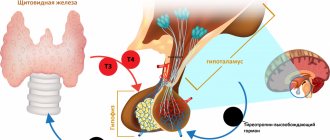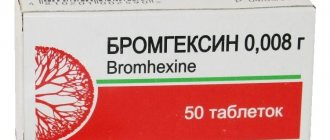> Home > Drugs > Full list > Over-the-counter drugs
Trade name: Bromhexine 4 Berlin - Hemi
International nonproprietary name: bromhexine
Chemical name: N - (2-amino-3,5 - dibromobenzyl) - N - methylcyclohexanamine hydrochloride
Dosage form: oral solution
Composition per 100 ml solution:
Active ingredient: bromhexine hydrochloride – 0.08 g;
Excipients: propylene glycol, sorbitol, apricot-scented aromatic concentrate, hydrochloric acid 0.1 M (3.5%) solution, purified water.
Description: transparent, colorless, slightly viscous liquid with a characteristic apricot odor.
Pharmacotherapeutic group: expectorant mucolytic agent
ATX code: R05CB02
Pharmacological properties
Pharmacodynamics
Bromhexine has a mucolytic (secretolytic) and expectorant (secretomotor) effect. Reduces the viscosity of sputum; activates the ciliated epithelium, increases the volume of sputum and improves its discharge. Stimulates the production of endogenous surfactant, which ensures the stability of alveolar cells during respiration. The effect appears within 2-5 days from the start of treatment.
Pharmacokinetics
Suction. After oral administration, bromhexine is quickly and almost completely absorbed from the gastrointestinal tract. The half-life of absorption is about 0.4 hours. The maximum concentration in the blood plasma after oral administration is reached after 1 hour.
Distribution. The volume of distribution is approximately 7 l/kg body weight. The degree of binding to plasma proteins is 99%. Bromhexine penetrates the blood-brain barrier and the placental barrier. Penetrates into breast milk and cerebrospinal fluid. Bromhexine does not accumulate.
Metabolism. 80% of bromhexine undergoes a “first pass” effect through the liver with the formation of biologically active metabolites. In severe liver diseases, a decrease in the clearance of bromhexine is observed.
Excretion. Bromhexine is excreted from the body mainly in the form of metabolites. The half-life to achieve the minimum effective concentration after achieving equilibrium between the processes of absorption and excretion is approximately 1 hour. The final half-life is approximately 16 hours due to the reverse distribution of small amounts of bromhexine from tissues.
It is excreted primarily by the kidneys in the form of metabolites formed in the liver. Due to the high degree of binding to plasma proteins and the high volume of distribution, as well as the slow redistribution from tissues to the blood, significant elimination of bromhexine by dialysis or forced diuresis should not be expected.
In severe renal failure, an increase in the half-life of bromhexine metabolites cannot be excluded. Nitrosation of bromhexine is possible under physiological conditions in the stomach.
Indications for use
Secretolytic therapy for acute and chronic bronchopulmonary diseases associated with impaired secretion and transport of sputum (for example, acute and chronic bronchitis, bronchiectasis, tracheobronchitis, pneumonia, emphysema, cystic fibrosis, tuberculosis, pneumoconiosis).
Contraindications
- hypersensitivity to bromhexine and other components of the drug;
- peptic ulcer of the stomach and/or duodenum (including a history);
- pregnancy (first trimester);
- breastfeeding period;
- children under 2 years of age;
- congenital fructose intolerance.
Carefully
- renal and/or liver failure;
- in case of impaired bronchial motility, accompanied by excessive accumulation of secretions;
- children aged from 2 to 6 years (used as prescribed by a doctor).
Use during pregnancy and breastfeeding
The use of the drug in the first trimester of pregnancy is contraindicated. In the second and third trimesters of pregnancy, the use of the drug is possible only if the expected benefit to the mother outweighs the possible risk to the fetus. The use of the drug during breastfeeding is contraindicated.
Directions for use and doses
Oral solution. 1 measuring spoon contains 5 ml of solution.
Unless otherwise prescribed, the following doses are recommended:
Adults and adolescents over 14 years of age: 3 times a day, 2-4 scoops (24-48 mg of bromhexine per day).
Children from 6 to 14 years of age, as well as patients weighing less than 50 kg: 3 times a day, 2 scoops (24 mg of bromhexine per day).
Children from 2 to 6 years: 3 times a day, 1 measuring spoon (12 mg of bromhexine per day) - used as prescribed by a doctor.
In case of impaired renal function and/or severe liver disease, the intervals between doses should be increased or the dose reduced. You should consult your doctor on this issue.
During therapy with Bromhexine 4 Berlin-Chemie, it is recommended to drink sufficient amounts of fluid.
Bromhexine 4 Berlin-Chemie should not be taken for more than 4-5 days without consulting your doctor. The duration of use is determined by the doctor individually and depends on the indications and course of the disease.
Side effect
Possible side effects are listed below in descending frequency of occurrence: very common (>1/10), common (>1/100, >1/10), uncommon (>1/1000, >1/100), rare (>1/100) 10000, <1/1000), very rare, including isolated reports (<1/10000), frequency not established (cannot be estimated from available data).
From the gastrointestinal tract
Uncommon: nausea, vomiting, diarrhea, abdominal pain;
From the immune system
Rarely: hypersensitivity reactions;
Frequency not established: anaphylactic reactions, including anaphylactic shock, angioedema, pruritus.
From the skin and subcutaneous tissues
Rarely: skin rash, urticaria;
Frequency not established: severe skin reactions, including erythema multiforme, Stevens-Johnson syndrome, toxic epidermal necrolysis (Lyell's syndrome), acute generalized exanthematous pustulosis (see section "Special instructions").
General violations
Uncommon: fever.
In case of all forms of allergic reactions (hypersensitivity, anaphylaxis) or in the event of any damage to the skin and/or mucous membranes, you must stop taking this drug and immediately inform your doctor.
Overdose
Life-threatening symptoms of overdose with Bromhexine 4 Berlin-Chemie are unknown.
Symptoms: A study of overdose cases has been published, according to which vomiting was observed in 4 out of 25 overdose cases. Three children experienced vomiting, as well as stunned consciousness, ataxia, diplopia, mild metabolic acidosis, and tachypnea. In children, symptoms did not occur when taking bromhexine at doses up to 40 mg, even in the absence of treatment.
There is no evidence of chronic toxicity of bromhexine in humans.
Treatment: in case of severe overdose, monitoring of blood circulation and, if necessary, symptomatic treatment are indicated. Due to the low toxicity of bromhexine, as a rule, there is no need for invasive measures aimed at reducing its absorption (forced vomiting, gastric lavage) or accelerating excretion. In addition, due to the pharmacokinetics (high volume of distribution, slow redistribution processes and high degree of protein binding), effective removal of bromhexine from the body by dialysis or forced diuresis should not be expected.
Since in children over 2 years of age, even after taking large doses of bromhexine, only mild symptoms are expected, with a dose of bromhexine hydrochloride up to 80 mg (for example, 100 ml of Bromhexine 4 Berlin-Chemie), detoxification may not be necessary. In younger children, the appropriate dose limit is 60 mg bromhexine hydrochloride (6 mg/kg body weight).
In case of overdose, it is also possible to develop side effects caused by excipients.
Interaction with other drugs
Bromhexine 4 Berlin-Chemie can be prescribed simultaneously with other drugs used in the treatment of bronchopulmonary diseases.
Bromhexine is not prescribed simultaneously with antitussives (including those containing codeine), because due to the suppression of the reflex, the evacuation of liquefied sputum is difficult, which can lead to the accumulation of secretions in the respiratory tract.
Bromhexine 4 Berlin-Chemie promotes the penetration of antibiotics (erythromycin, cephalexin, oxytetracycline, ampicillin, amoxicillin) into bronchial secretions in the first 4-5 days of antimicrobial therapy. The clinical significance of this possible interaction has not been proven.
When used simultaneously with drugs that irritate the gastrointestinal tract (for example, some non-steroidal anti-inflammatory drugs), the irritant effect of the latter on the gastric mucosa may be increased.
special instructions
In cases of impaired bronchial motility or with a significant volume of sputum secreted (for example, in the rare syndrome of primary ciliary dyskinesia), the use of Bromhexine 4 Berlin-Chemie requires caution due to the increased risk of airway obstruction.
In case of impaired renal function and severe liver disease, Bromhexine 4 Berlin-Chemie should be used with extreme caution (for example, it is recommended to reduce the dose or increase the intervals between doses). In severe renal failure, it is necessary to take into account the possibility of accumulation of metabolites formed in the liver.
Monitoring of liver function is recommended, especially during long-term treatment.
There is evidence of the occurrence in very rare cases of severe skin reactions (such as erythema multiforme, Stevens-Johnson syndrome, toxic epidermal necrolysis, acute generalized exanthematous pustulosis) while taking bromhexine.
If allergic reactions and/or signs of progressive skin rash occur (sometimes in combination with the appearance of blisters and damage to the mucous membranes), you should immediately stop using the drug and consult a doctor.
The use of Bromhexine 4 Berlin-Chemie in children over 2 years of age is possible only under the supervision of a physician.
Propylene glycol, which is part of the drug Bromhexine 4 Berlin-Chemie, can cause symptoms in children similar to those that occur after drinking alcohol.
Instructions for patients with diabetes: 5 ml of solution (1 scoop) contains 2 g of sorbitol (equivalent to 0.5 g of fructose), which corresponds to 0.17 bread units.
Sorbitol may have a slight laxative effect.
The effect of the drug on the ability to drive vehicles and machinery
When taken in recommended doses, Bromhexine 4 Berlin-Chemie does not affect the speed of psychomotor reactions.
Release form
Oral solution 4 mg/5 ml.
60 or 100 ml of solution in dark glass bottles with a screw-on plastic or aluminum stopper with a sealing gasket.
1 bottle complete with a measuring spoon along with instructions for use is placed in a cardboard box.
Storage conditions
At a temperature not higher than 25 oC.
Keep the medicine out of the reach of children!
Best before date
3 years.
3 months - after the first opening of the bottle.
Do not use after the expiration date stated on the packaging.
Vacation conditions
Available without a prescription.
Manufacturer
Berlin-Chemie AG
Glinker Weg, 125
12489 Berlin, Germany
Organization receiving complaints from consumers:
LLC "Berlin-Chemie/A. Menarini", Russia
123112, Moscow, Presnenskaya embankment, building 10, Business Center "Tower on the Embankment", Blok, tel., fax.
Pharmacodynamics and pharmacokinetics
Bromhexine 8 Berlin-Chemie is characterized by secretolytic (mucolytic) and secretomotor (expectorant) effectiveness, and also has a weak antitussive effect. Taking the drug reduces the viscosity of bronchial secretions , stimulates ciliated epithelial , increases the amount of sputum and promotes its rapid discharge. In addition, the drug activates the production of endogenous surfactant the alveolar epithelium during respiration . The maximum effectiveness of therapy is observed on days 2-5 from the start of taking the drug.
When taken orally (inside) for 30 minutes, almost complete absorption of bromhexine (99%) in the gastrointestinal tract is observed. The bioavailability of the drug is at the level of 80%. Bromhexine is 99% bound to plasma proteins It has the ability to penetrate the blood-brain and placental barriers, as well as into the milk of a nursing mother. Hepatic metabolic transformations occur through oxidation and demethylation , up to the formation of ambroxol . The average T1/2 due to slow reverse tissue diffusion is 15 hours. Excretion is carried out by the kidneys (urine) in the form of metabolites . Repeated use leads to the accumulation of the drug in the human body. With chronic renal failure of metabolic products is impaired.
Types of inhalers
The inhalation therapy method is based on the penetration of medicinal substances into the respiratory tract in the form of an aerosol, that is, tiny particles suspended in a gaseous medium. If aerosol is inhaled:
- particles larger than 5 microns settle in the oral cavity and upper respiratory tract;
- particles from 1 to 5 microns settle in the lower respiratory tract;
- particles with a diameter less than 1 micron are exhaled back.
Inhalers are divided into types depending on the mechanism of particle formation.
Ultrasonic nebulizers
In ultrasonic inhalers, the drug is atomized due to high-frequency vibration of piezoelectric crystals.
Research shows that ultrasonic inhalations are effective due to the spraying of not only the medicinal substance itself, but also negatively charged particles, which have an additional anti-inflammatory effect.
However, this type of inhaler has a drawback: exposure to ultrasound destroys many medications (for example, antibiotics and phlegm thinners).
Compressor inhalers
A compressor inhaler converts the drug into a fine aerosol using compressed air from a compressor.
The compressor inhaler is considered the most effective for affecting all parts of the respiratory tract. Its great advantage is the creation of an aerosol suspension with a very small particle size of the drug substance. You can use any medications that are intended for inhalation.
Steam inhalers
Based on the evaporation of medicinal substances under the influence of high temperatures.
Flaws:
- you can get a burn to the mucous membrane;
- affect only the upper respiratory tract;
- at high heating temperatures they reduce the biological activity of medicinal substances.
In medical practice, two types of inhalers are usually used: compressor and ultrasonic.
Analogs
Level 4 ATX code matches:
Mukolik
Abrol
Ambrosan
Bronchorus
ACC 100
ACC 200
ACC Long
ACC
Mukolwan
Lazolvan
Bromhexine 8
Bromhexine
Bronchobos
Carbocisteine
Erdomed
Pulmozyme
Pectolvan C
Halixol
Ambrobene
Acetylcysteine
- Ambrobene;
- ACC;
- Acestine;
- Libexin;
- Ambroxol;
- Bronchoxol;
- Ascoril;
- Lazolvan;
- Sinupret;
- Fluditek;
- Flavamed;
- Fluimucil;
- Halixol , etc.
Interaction
The drug is not compatible with alkaline solutions .
Due to the difficulty of removing liquefied sputum , the combined use of the drug with drugs that have a depressing effect on the cough center (including codeine-containing drugs ) should be avoided.
In the first 4-5 days of antibiotic therapy using Amoxicillin , Erythromycin , Oxytetracycline , Cephalexin and Ampicillin and simultaneous administration of Bromhexine bronchial secretions may increase .
Side effects
As a rule, treatment with bromhexine is tolerated without any negative effects.
In some rare cases, the following were observed: nausea / vomiting , dyspeptic , dizziness , exacerbations of peptic ulcers , shortness , headaches , chills, fever, as well as allergic manifestations (skin rash , swelling , rhinitis ).
anaphylactic shock may occur .
Sometimes an increase in the activity of liver transaminases .
If any allergic , you must stop taking bromhexine and inform your doctor about the observed symptoms.
Indications for use
The use of Bromhexine Berlin-Chemie is indicated in the case of bronchopulmonary diseases of a chronic or acute course, accompanied by the production of viscous sputum:
- pneumoconiosis;
- bronchial asthma;
- cystic fibrosis;
- pneumonia;
- emphysema ;
- tracheobronchitis;
- bronchiectasis;
- obstructive bronchitis;
- tuberculosis.
Overdose
No life-threatening adverse effects were observed when taking excessive doses of bromhexine Possible symptoms of overdose were limited to nausea / vomiting , diarrhea and other dyspeptic symptoms.
The recommended treatment is to induce vomiting and cleanse the gastrointestinal tract (if an overdose is detected in the first 60-120 minutes). Subsequent therapy should be appropriate to the observed symptoms.
Contraindications
Taking bromhexine is absolutely contraindicated if:
- breastfeeding;
- personal hypersensitivity to bromhexine and/or other components of the drug;
- sugar intolerance;
- pregnancy in the first trimester;
- exacerbation of peptic ulcer ;
- under the age of 6 years.
Relative contraindications are:
- / liver pathologies ;
- tendency to gastrointestinal bleeding ;
- disturbances of bronchial motility with excessive concentration of secretions.
special instructions
During therapy, you need to consume an increased amount of fluid, which helps to increase the secretolytic effectiveness of Bromhexine .
If bronchial motility or if there is a large volume of sputum , caution should be exercised, as these conditions contribute to the retention of secretions .
In case of severe kidney pathologies, Bromhexine .
In order to facilitate the removal of bronchial secretions , it is recommended in childhood to combine Bromhexine with vibration massage of the chest or postural drainage .



